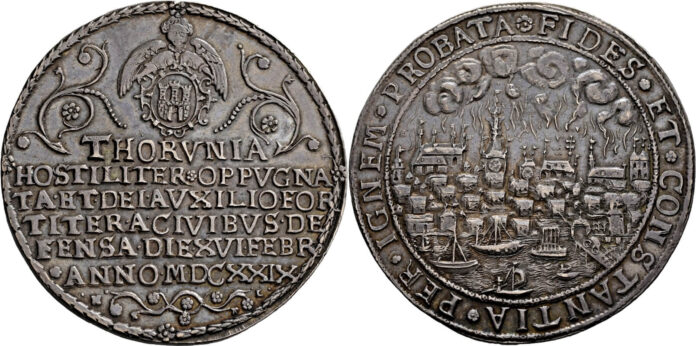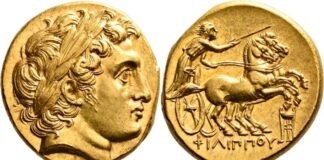High Demand Of Top Quality Coins at Peus
In times of closed gastronomy and dormant club life, the customers of Busso Peus were fortunately able to experience the 427th auction live on the floor and visibly enjoyed the atmosphere. Most of the bids, however, went to the online and telephone bidders, whom Peus would like to thank for the excellent result.
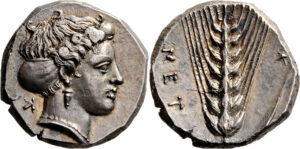
Among the Greek coins in the Graeculus Collection, it was the small coins in particular, the exquisite quality of which, combined with a decent provenance, consistently resulted in high prices. The river god on a litra from Gela (Lot 109) cast a spell over two bidders in such a way that they multiplied the estimate from € 200 to € 1,800. With a litra from Himera (Lot 117) it was probably the untouched surface that drove the price from € 250 to € 1,200. The pretty Syracusan dilitron (Lot 164) with an auction provenance from 1904 rose from € 500 to € 2,600. Another dilitron (Lot 189) probably owed a price jump from 1,250 € to 6,000 € to its Fleur de Coin and the iridiscent toning. Lot 269, a hemiobol from Aegina (Estimate 500 €), was only allowed to go to its new owner at 2,600 €.
But the very high prices were naturally reserved for the large denominations. A high-class didrachm of Metapontum (Lot 59) clearly exceeded its estimate of € 2,500 with a hammer price of € 7,000. The wonderful nomos of Kaulonia (Lot 80) brought in a respectable result with 8,500 € (estimate 4,000 €). A classic stater from Corinth with a somewhat dull Pegasus, but a very pretty Athena head, was increased from € 500 to € 7,500 (Lot 270). The late Archaic drachm from Paros (Lot 293) turned out to be the top piece. Its price rose, not least because of its prominent position in a publication and its origins in the Niggeler collection, from € 3,500 to € 17,000. And the bronzes did not disappoint either: the bidding war for lot 70, a bronze from Paestum with an estimate of € 200, only ended at € 3,000.
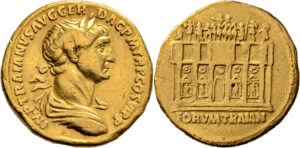
In the area of Roman antiquity, the denarii of Dr. Rattinger, especially the collector-friendly lots, consistently sold very good. Some aurei, such as the one with an architectural depiction of Traianus (Lot 401, estimate 2,000 €), achieved good prices of 3,400 € despite being somewhat poorly preserved. A rare piece by Lucilla (Lot 531, estimate € 750), fetched € 2,800.The estate, especially the library, of the Islam specialist Reiner Seupel was very well received.
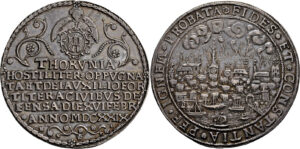
The general strength of the online bidders was also evident in the field of world coins and here once again among the non-German and Habsburg coins in particular. The beautiful collection of the Netherlands with the numerous ducats obviously gathered many interested parties in front of the computers, so that particularly strong results were achieved here. The title piece, a wonderful “Brandtaler” from the city of Thorn from 1629, attracted no less than nine telephone bidders in addition to the hall and internet bidders, which made the hammer only fall at € 70,000. On the other hand, the Russian rarities were accepted differently, sometimes bid numerously, and sometimes found less attention. The well-kept collection of beautiful Habsburg coins attracted greatest attention from the international public, and the long-standing popularity of Czech and Hungarian mints continued to be confirmed. In addition, the series of original 4 ducat pieces was very well received. A general trend towards gold coins was observed throughout the world coin auction.
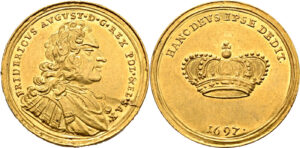
Among the German feudal coins, the Brandenburg-Prussian coins achieved the expected good prices and the series of Brunswick “Lösers” also gathered telephone and internet bidders in addition to the hall. In the further course, a Saxon double ducat of 1697 on the Polish royal coronation of August II “the Strong” was noticed and sold for € 21,000 in the hall. The following German imperial coins were strongly pre-bid, so that mail-bidders prevailed against the Internet. In the end, as usual, the moderately taxed combined lots achieved surprisingly high prices, so that the auction came to a very satisfactory end. The auction house thanks all consignors, colleagues and of course all collectors who contributed to this successful auction.
You can find all results on the Peus website.
Unsold pieces may be purchased up to five weeks after the sale for 80% of the estimate under normal conditions of sale, plus buyers-premium and eventual taxes through Auex. Here you come to the unsold lots still available.



